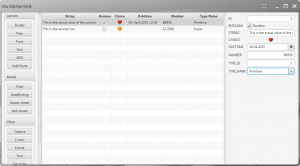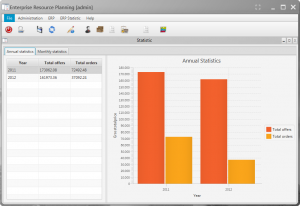JavaFX, JVx and data binding
We made great progress with our JavaFX UI for JVx. The whole UI stuff was already implemented and worked with some known problems. The next thing was data binding because this should fill the gap between UI and business logic. This means: bindings for a table, tree, chart, editors, cell editors, cell renderers, ... (hard work).
The data controls of JavaFX were very useful and we didn't implement our own controls because standard controls were working. Sure, we had a different model in JVx than the "model" in JavaFX, but also Swing and vaadin had different models. We're experts in such things.
We started with the table, because a table implementation should be easy without CRUD operations and of course, it was easy. The next thing was the integration of our cell renderers and cell editors because a date field should automatically use a date editor and a number field should use a number(only) editor. The same applies for checkboxes and comboboxes. This was a hard job because JavaFX' table had different concepts than e.g. swing. We're still working on the last bits but most functionality was implemented.
It's already possible to bind a database table/view to a JavaFX TableView without additional JDBC, ORM. Thanks to JVx, this works with all supported architectures (mem, 2-tier, 3-tier). Here's a first impression, followed by the source code:
table.setDataBook(dataBook);
UIFormLayout editorsPaneLayout = new UIFormLayout();
editorsPaneLayout.setNewlineCount(2);
UIPanel editorsPane = new UIPanel();
editorsPane.setLayout(editorsPaneLayout);
addEditor(editorsPane, dataBook, "ID");
addEditor(editorsPane, dataBook, "BOOLEAN");
addEditor(editorsPane, dataBook, "STRING");
addEditor(editorsPane, dataBook, "CHOICE");
addEditor(editorsPane, dataBook, "DATETIME");
addEditor(editorsPane, dataBook, "NUMBER");
addEditor(editorsPane, dataBook, "TYPE_ID");
addEditor(editorsPane, dataBook, "TYPE_NAME");
UISplitPanel splitPanel = new UISplitPanel(UISplitPanel.SPLIT_LEFT_RIGHT);
splitPanel.setDividerAlignment(UISplitPanel.DIVIDER_BOTTOM_RIGHT);
splitPanel.setFirstComponent(table);
splitPanel.setSecondComponent(editorsPane);
UIPanel content = new UIPanel();
content.setLayout(new UIBorderLayout());
content.add(splitPanel, UIBorderLayout.CENTER);
(see Kitchensink application, hosted on github)
This was the whole source code for the table binding (= UI). The missing piece is the model. In our example, we've used the member dataBook. A databook is the model and controller of JVx. We have different implementations: MemDataBook, RemoteDataBook. A mem is like a database table, but in memory. A remote databook is connected to a remote/local storage. The storage provides data (from a database, filesystem, twitter, ...).
We didn't use a database in our kitchensink, so the dataBook was defined as MemDataBook:
rowdef.addColumnDefinition(new ColumnDefinition("ID",
new BigDecimalDataType()));
rowdef.addColumnDefinition(new ColumnDefinition("STRING",
new StringDataType(new UITextCellEditor())));
rowdef.addColumnDefinition(new ColumnDefinition("BOOLEAN",
new BooleanDataType(new UICheckBoxCellEditor(
Boolean.TRUE, Boolean.FALSE))));
rowdef.addColumnDefinition(new ColumnDefinition("CHOICE",
new StringDataType(choiceCellEditor)));
rowdef.addColumnDefinition(new ColumnDefinition("DATETIME",
new TimestampDataType(new UIDateCellEditor("dd.MM.yyyy"))));
rowdef.addColumnDefinition(new ColumnDefinition("NUMBER",
new BigDecimalDataType(new UINumberCellEditor())));
rowdef.addColumnDefinition(new ColumnDefinition("TYPE_ID",
new BigDecimalDataType()));
rowdef.addColumnDefinition(new ColumnDefinition("TYPE_NAME",
new StringDataType(
new UILinkedCellEditor(referenceDefinition))));
IDataBook dataBook = new MemDataBook(rowdef);
dataBook.setName("DATABINDING");
dataBook.open();
It's the definition of a table with some columns and different column types, like String, Date, Number, ComboBox. It's easy to use a real database table if you read following article or this one.
The difference
What's the difference to standard JavaFX without JVx and why should you use JVx?
Here's the official documentation of Table View from Oracle. It's very complex to work with tables ![]() (seems to be so). The example in the official documentation doesn't use a database, like our example above!
(seems to be so). The example in the official documentation doesn't use a database, like our example above!
The first difference: Save time and LoC.
This will reduce complexity and saves your dev time. It'll be easier to maintain an application with 1.000 LoC instead of 50.000.
Second difference: JVx already is a framework and library - don't create your own and waste dev time.
Advantage of JVx: Simply bind a database table with 10 LoC:
dba.setUsername("sa");
dba.setPassword("");
dba.open();
DBStorage dbs = new DBStorage();
dbs.setDBAccess(dba);
dbs.setWritebackTable("testtable");
dbs.open();
StorageDataBook dataBook = new StorageDataBook(dbs);
dataBook.open();
This is enough to get full CRUD support for your tables.
This article was the first intro of our databinding implementation for JavaFX. The next artile will cover our chart implementation. Here's first a impression:
We love the clean UI of JavaFX and our maximized internal frames ![]()



 RSS-Feed
RSS-Feed